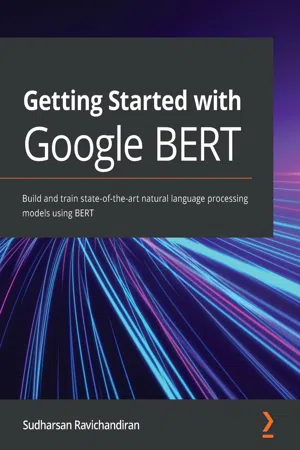
Getting Started with Google BERT
Build and train state-of-the-art natural language processing models using BERT
- 352 pages
- English
- ePUB (mobile friendly)
- Available on iOS & Android
Getting Started with Google BERT
Build and train state-of-the-art natural language processing models using BERT
About this book
Kickstart your NLP journey by exploring BERT and its variants such as ALBERT, RoBERTa, DistilBERT, VideoBERT, and more with Hugging Face's transformers library
Key Features
- Explore the encoder and decoder of the transformer model
- Become well-versed with BERT along with ALBERT, RoBERTa, and DistilBERT
- Discover how to pre-train and fine-tune BERT models for several NLP tasks
Book Description
BERT (bidirectional encoder representations from transformer) has revolutionized the world of natural language processing (NLP) with promising results. This book is an introductory guide that will help you get to grips with Google's BERT architecture. With a detailed explanation of the transformer architecture, this book will help you understand how the transformer's encoder and decoder work.
You'll explore the BERT architecture by learning how the BERT model is pre-trained and how to use pre-trained BERT for downstream tasks by fine-tuning it for NLP tasks such as sentiment analysis and text summarization with the Hugging Face transformers library. As you advance, you'll learn about different variants of BERT such as ALBERT, RoBERTa, and ELECTRA, and look at SpanBERT, which is used for NLP tasks like question answering. You'll also cover simpler and faster BERT variants based on knowledge distillation such as DistilBERT and TinyBERT. The book takes you through MBERT, XLM, and XLM-R in detail and then introduces you to sentence-BERT, which is used for obtaining sentence representation. Finally, you'll discover domain-specific BERT models such as BioBERT and ClinicalBERT, and discover an interesting variant called VideoBERT.
By the end of this BERT book, you'll be well-versed with using BERT and its variants for performing practical NLP tasks.
What you will learn
- Understand the transformer model from the ground up
- Find out how BERT works and pre-train it using masked language model (MLM) and next sentence prediction (NSP) tasks
- Get hands-on with BERT by learning to generate contextual word and sentence embeddings
- Fine-tune BERT for downstream tasks
- Get to grips with ALBERT, RoBERTa, ELECTRA, and SpanBERT models
- Get the hang of the BERT models based on knowledge distillation
- Understand cross-lingual models such as XLM and XLM-R
- Explore Sentence-BERT, VideoBERT, and BART
Who this book is for
This book is for NLP professionals and data scientists looking to simplify NLP tasks to enable efficient language understanding using BERT. A basic understanding of NLP concepts and deep learning is required to get the best out of this book.
Frequently asked questions
- Essential is ideal for learners and professionals who enjoy exploring a wide range of subjects. Access the Essential Library with 800,000+ trusted titles and best-sellers across business, personal growth, and the humanities. Includes unlimited reading time and Standard Read Aloud voice.
- Complete: Perfect for advanced learners and researchers needing full, unrestricted access. Unlock 1.4M+ books across hundreds of subjects, including academic and specialized titles. The Complete Plan also includes advanced features like Premium Read Aloud and Research Assistant.
Please note we cannot support devices running on iOS 13 and Android 7 or earlier. Learn more about using the app.
Information
- Chapter 1, A Primer on Transformers
- Chapter 2, Understanding the BERT Model
- Chapter 3, Getting Hands–On with BERT
- Introduction to the transformer
- Understanding the encoder of the transformer
- Understanding the decoder of the transformer
- Putting the encoder and decoder together
- Training the transformer
Introduction to the transformer
Table of contents
- Title Page
- Copyright and Credits
- Dedication
- About Packt
- Contributors
- Preface
- Section 1 - Starting Off with BERT
- A Primer on Transformers
- Understanding the BERT Model
- Getting Hands-On with BERT
- Section 2 - Exploring BERT Variants
- BERT Variants I - ALBERT, RoBERTa, ELECTRA, and SpanBERT
- BERT Variants II - Based on Knowledge Distillation
- Section 3 - Applications of BERT
- Exploring BERTSUM for Text Summarization
- Applying BERT to Other Languages
- Exploring Sentence and Domain-Specific BERT
- Working with VideoBERT, BART, and More
- Assessments
- Other Books You May Enjoy